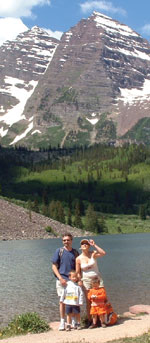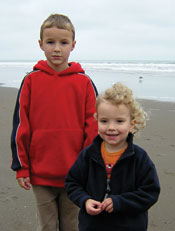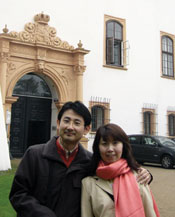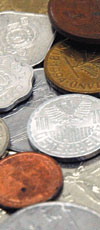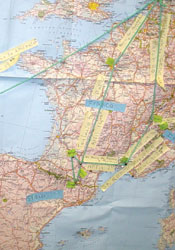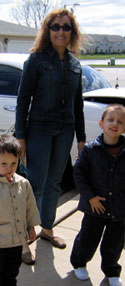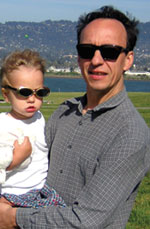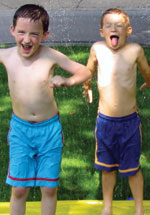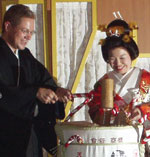Physicists in the global era by Heather Rock Woods Scientists and their families are finding they must adapt to the increasingly international nature of particle physics. The effects on family life go far beyond jet lag and it's up to individuals to navigate the foreign terrain. Paris-based particle physicist Pierre Antilogus spends more than a month a year at his experimental site, lately Hawaii. He missed his youngest daughter's first birthday and his oldest daughter's sixth birthday this past year, during travel to Lawrence Berkeley National Laboratory (LBNL), California, and Mauna Kea, Hawaii, to prepare and install a supernova-detecting spectrograph in a telescope. Antilogus is officially a researcher at Laboratoire de Physique Nucléaire et de Haute Energies (LPNHE). "For the small kids, it's really difficult to handle when one of the parents is not around," he says. "For example, five weeks away for a one-year- old baby: when she saw me again for the first time, she opened her big eyes and started a terrible cry…five minutes later she wanted to come in my arms and stayed glued to me for half an hour like a small animal. Five weeks away for a six-year-old kid, you got a letter two weeks after you leave: ‘Dad, you should come back NOW, I'm too sad when you are not here.' "So on the kid side, when you leave you should try to set up a minimum of support for the mother. But anyway, it will be hell. We try to have a 50 percent share among us for what should be done for the family. My wife is working a lot too and she has then a full double agenda when I'm not here. It's clear that this generates tension between us." Antilogus does try to make it up to his wife. "Indeed, when I'm back, I'll try to work a bit less and pick up more often the kids, or get up first more often in the mornings. " Also, when I travel, this can make real to my kids a few facts. My 6-year-old daughter realized this year, when I was in Hawaii, that the sun is always shining somewhere on Earth," he grins.
Thirty years ago, the American particle physics landscape looked very different. Nobel Prize-winning experiments had nine people on their teams. Foreign scientists were part of the mix, but collaborations involved few, mostly domestic, institutions. Even at CERN, the European Organization for Nuclear Research, an international organization from its inception in 1954, the lab acted more as a regional facility for a small continent, says James Gillies, its head of education and communication. Now collaborations routinely involve 300 to 800 physicists and engineers. Two of the detector collaborations for the Large Hadron Collider (LHC) being built at CERN in Geneva each have about 2000 people from 36 countries. Even particle accelerators, once the province of their operating labs, are beginning to be designed and built by international collaborations. Working internationally is now a necessary ingredient of many particle physics projects. New questions about our universe require telescopes looking farther into space and higher-energy accelerators that take many nations to plan, build, fund, and operate. "This is the only way I can do research. All interesting research projects today use many people and funding difficult to find in a single country," Antilogus says. "The ones who can't travel at all are in trouble—they will not be able to contribute to experimental research today." Frequent emails and hours-long conference calls and videoconferences are part of the package. But travel, including relocation, is necessary to test and install equipment, oversee an experiment, take data, work out issues face-to-face, and present results. To save money and not interfere with teaching duties, trips often go through weekends. Yuji Yamazaki, a researcher for KEK in Japan, essentially relocated to DESY in Germany nine years ago to oversee a hardware system for the ZEUS experiment. His wife, a pianist, cannot work in Germany. "My wife is learning German but still does not have many friends. I am sure she feels herself quite isolated and this is indeed a possible problem," he says. Yamazaki relies on technology to enable him to spend more time with his wife. "I think the best thing to make it easier is to stay home as much with her by bringing back some work to home. In this sense, the recent development of the broadband connection has been the best technology to make the foreign life easier."
|
For better and for worse, physicists and their families continue to join the global village in growing numbers to do the work they love. Families can gain much: foreign friends, overseas vacations, vibrant cultural exchanges, and the children's introduction to the world at a young age. But sometimes, the benefits come at the expense of a baby who doesn't immediately recognize a parent after a long trip, a spouse with a sidelined career, or the family feeling linguistically and culturally illiterate in a foreign environment. "Not much is done in our profession to take care of family life," says Steve Goldfarb, an American researcher for the University of Michigan, based at CERN for the last 16 years. He married a local Frenchwoman and has two kids, ages one and four. "This has nothing to do with being abroad or not," he says. "Just a problem that will take many generations to solve, if we are so motivated. In my situation, I have had to trade in the pursuit of tenure in order to remain here at CERN with my wife and family." As a software coordinator on the giant ATLAS collaboration, Goldfarb sees lots of families coming and going. "Sometimes families are split up for up to a year at a time," he says. "Sometimes spouses have to give up jobs to follow the other's career path. Sometimes children have to spend a year attending school in a different language. I have seen people come here and like it and want to stay. I have also seen couples split up or families have to move back before they had planned. "The cultural change itself is rarely a factor. Taking a spouse away from a job and putting them some place where they cannot work and are somewhat isolated is probably the biggest problem for couples." |
Families aren't entirely on their own. CERN and other labs do have users' offices that provide assistance with foreign paperwork, and with local information and customs. Technologies and situations called for by the science can prove beneficial to families, but only by coincidence. For example, the proposed International Linear Collider project is exploring the possibility of using remote control rooms that would allow people to take shifts at their home institutions.
"Everyone seems to have found some way of coming to terms with it," says Archana Sharma, an applied physicist at CERN who travels frequently. In her experience, she and her collaborators generally do not plan around families, and she sees the benefits of international work as solely professional. Still, given their work demands, many scientists try to compensate for the difficulties and provide some advantage for their families. After a trip, Sharma spends extra time with her family and cooks them a special meal with food from the place she's just visited. Physicists, whose bread-and-butter is solving challenges, are applying their inventiveness to life outside the lab. Some limit their travel time when their children are young; some rotate travel obligations with co-leaders; some families plan their vacations to coincide with conferences and meetings; some spouses choose flexible job arrangements. And some working groups are flexible enough to allow planning around important family events, like 10th wedding anniversaries, births, and children leaving for college. Some physicists say their colleagues and supervisors are understanding about family needs.
Patrizia Azzi and her husband are both staff researchers for Instituto Nazionale di Fisica Nucleare (INFN) in Padova, Italy, but they spent the last 14 years primarily at Fermilab near Chicago. They just moved back to Italy this April. Their boys, ages three and five, were born in Naperville, Illinois. While based at Fermilab, Azzi traveled back to Italy for work three or four times a year. Now she comes to Fermilab one week out of six. "We tried very hard so that my husband's trips and mine were always short and well coordinated," Azzi says. "It was tricky. More than emotional stress, it takes a lot of high-level organization and a lot of money—we needed to have houses in Italy and Chicago, double cars, and paying for the airline tickets of the kids is not cheap either. Stress on the marriage is already a lot, just given the high-pressure job that we do. It takes a lot of energy to keep the focus on the right values." Their children "had a priceless exposure to different language and culture and the opportunity to make twice the friends," she says. The downside was living far from their aging grandparents who can't travel much. One key advantage of relocating to Fermilab was the on-site daycare. It "allowed me to have two wonderful kids and an effective career. This would have been impossible in Italy. So the main benefit is they have a happy mom who still does what she likes the most," Azzi says. Choosing and attending school, daycare or summer camp in a foreign environment can generate both added challenges and rewards for families with young children.
Particle astrophysicist Reynald Pain, at the Institut National de Physique Nucléaire et de Physique des Particules (IN2P3), took his family from Paris to Berkeley, California, for eight months this year to work closely with long-time collaborators at LBNL. He waited until his wife, university professor Sylvie Fol, could take a sabbatical from teaching. Their children attended a French-American school. Samuel, who turned seven during the trip, adapted quickly and happily. Alice, age three, "had difficulties getting used to the school and to being here," says Fol. "She was not speaking at all for a few months to her teachers, in French or English." Finding summer camps was challenging, but camp proved to be a great way to immerse the kids in English. "In two weeks they made huge progress, it was really amazing. On the other hand, they are completely exhausted even on weekends," says Fol. The family has enjoyed living in Berkeley. They also took a vacation in Hawaii at the end of one of Pain's work trips there. Pain normally goes to Hawaii two or three times a year for experimental observations, but it's almost 24 hours of travel each way from Paris—"impossible" with the kids. "As a rule, the international experience is very, very rich, even if there are some material effects in daily life that can be annoying," Fol concludes. |
|
The international experience prevails for those working on the LHC, the biggest particle physics machine to be built with strong international participation. Engineer Jim Kerby knows the situation well. For seven years, he's been traveling to CERN about four times a year, for a week at a time. He's the project manager for the Fermilab LHC Accelerator Project, which also involves collaboration and travel to KEK in Japan and LBNL, adding up to about eight trips a year. He has some flexibility in scheduling the trips to work around his family's activities. His children, ages five, seven, and nine, "say, ‘Daddy's going on a trip again,' and they're pretty cool with that," he says. "It's getting easier as the kids get older. It's still hard on my wife when I'm gone. She does keep track of the days I'm gone. I think it is hard on the marriage… but whatever she says is right."
She says, "it wasn't a huge strain on us." "He really started traveling a lot when we had three kids under the age of five," says Kerby's wife Sue, the daughter of a Fermilab physicist. "When you go international, it's at least a seven-day trip and you have to leave on Saturday to be there Monday. It involves one or two week- ends. It was really tough when they were little. Fortunately, I had a huge support network—the kids' grandparents. That was the thing that probably held me together. Now, to be honest, it's really not difficult when he travels. We've got into a routine with school and activities. Before, you didn't know at what hour is the one-year-old going to cry for 20 minutes, and the other kid vomit." "We have a world map in the family room and I show the kids the places I've been," Jim says. "It doesn't hurt them to look at a map and see there's a world out there." Sue says, "the kids get excited to know their dad travels to different countries. And he brings back Swiss chocolate. The kids don't let him in the door unless he shows them the chocolates."
For Stanford Linear Accelerator Center physicist Marc Ross, the rewards of international collaboration have also been sweet. For the past six years, he has traveled from California to KEK's linear collider test facility four times a year, for two to three weeks at a stretch. That amounts to 15 to 20 percent of his time. He stays with other SLAC physicists in a traditional Japanese house that SLAC rents year-round. "I'm more fascinated by the culture the more I learn about it," says Ross, who is becoming conversant with Japanese customs and cultures, can speak simply in Japanese, and read the paper with the aid of an electronic translation dictionary. On one of his transpacific flights he befriended a Japanese woman; Ross's family and her family have since visited each other.
"That connection for me is most phenomenal, and it's not through physics," he says. His children, ages 17 and 20, "enjoy the whole travel-ing thing, especially when there's another family involved. For them it's invaluable to experience a completely alien lifestyle." Satoshi Ozaki, after working in the United States for two dozen years, returned to Japan in the 1980s to oversee building the TRISTAN collider at KEK. He deliberately injected international participation into the detector collaborations to "open Japan's high energy physics to the world," he says. Now back at Brookhaven National Laboratory in New York, he travels and frequently calls across three continents as chair of the International Linear Collider Steering Committee task force on coordinating international design of the proposed collider. Yet Ozaki says the task force has not considered how to mitigate the effects on family life of relocating scientists for several years. "High energy physicists are international creatures," he says. And, by necessity, their families are, too. But whether the work culture can or will adapt for family needs as much as families currently adapt for the work is one of the modern questions confronting particle physics. Click here to download the pdf version of this article. |



